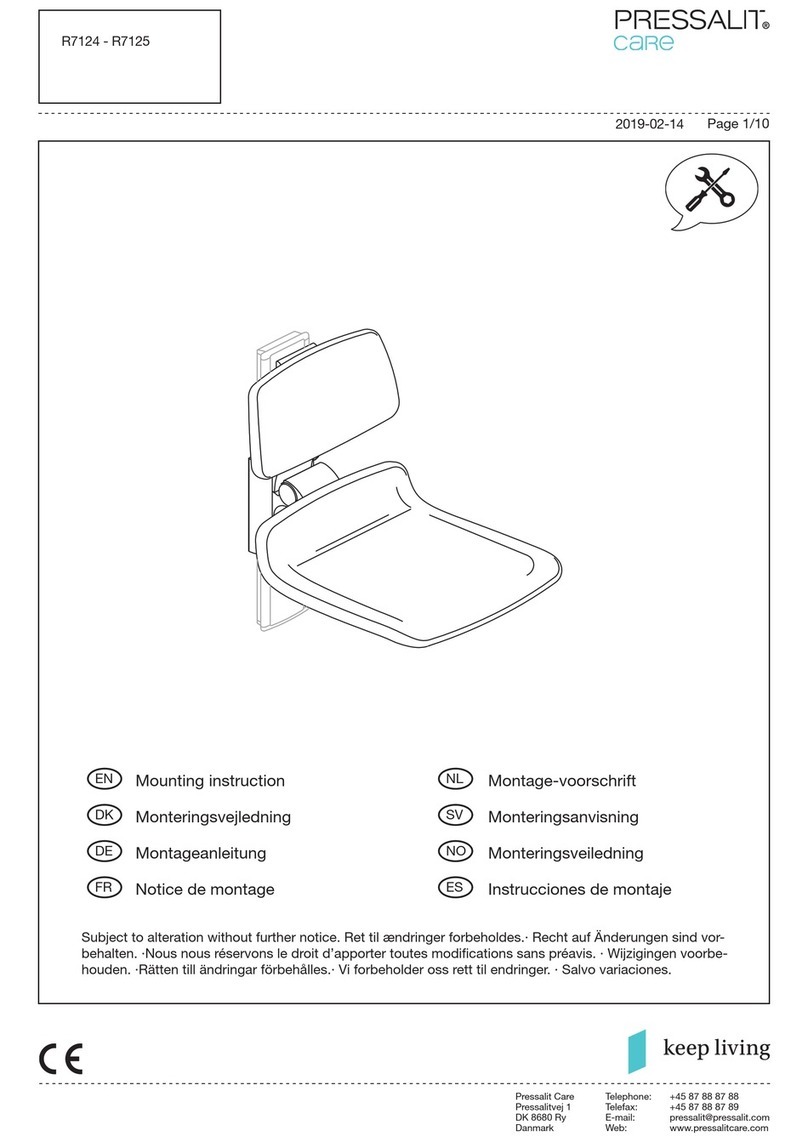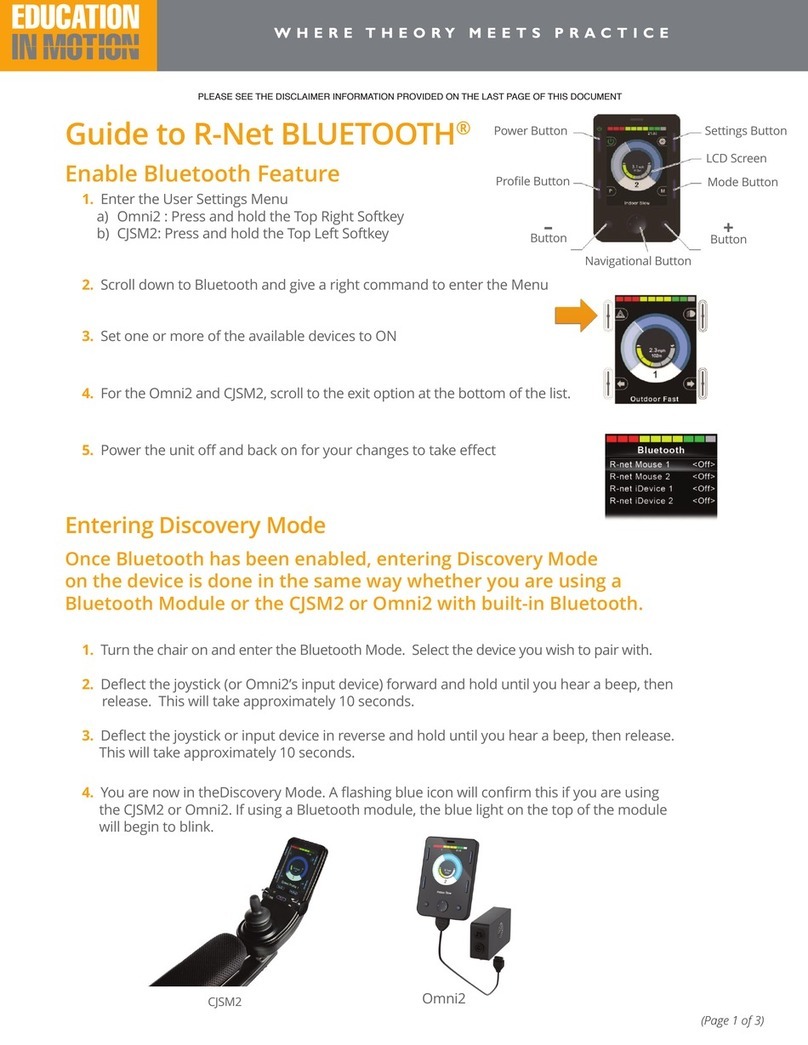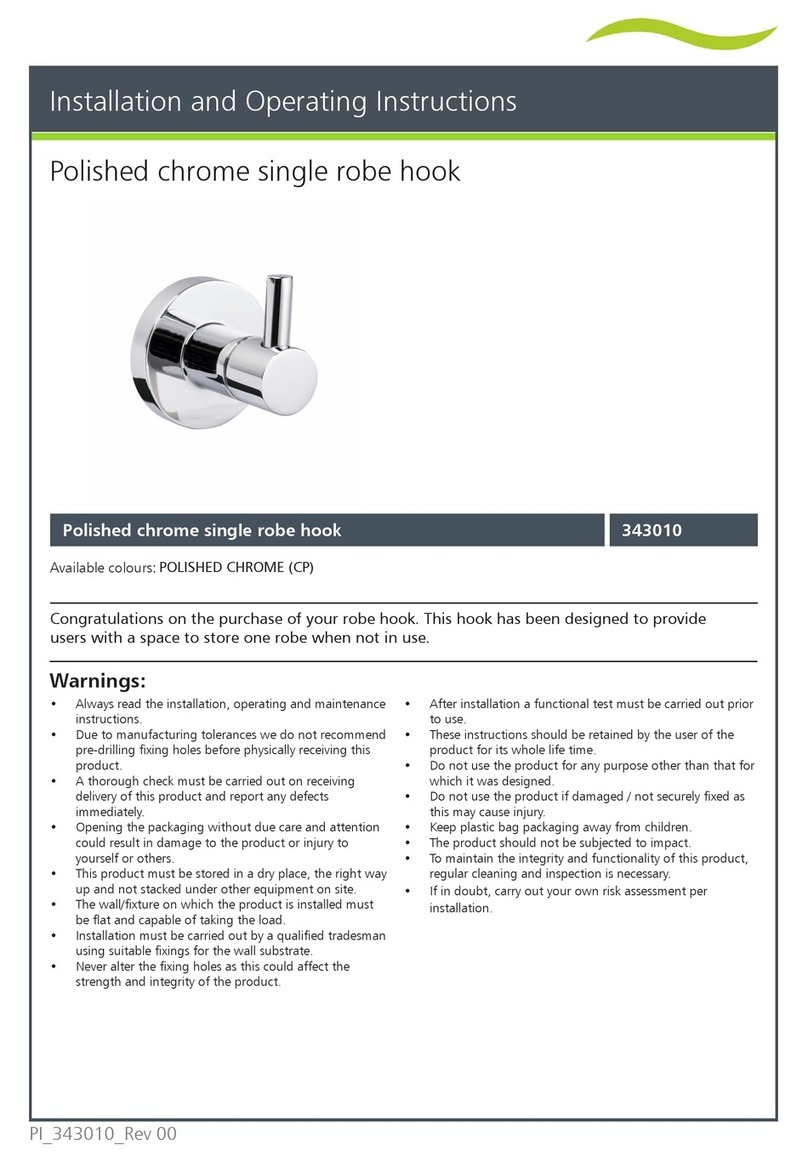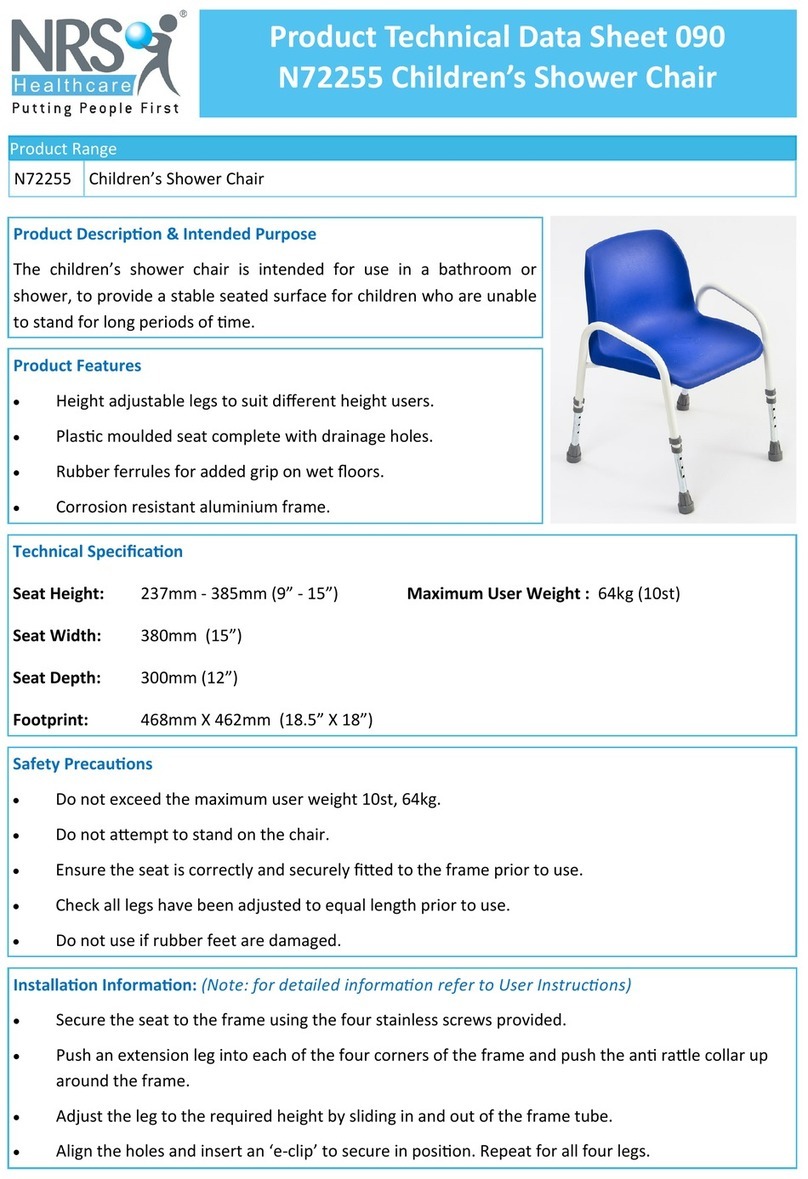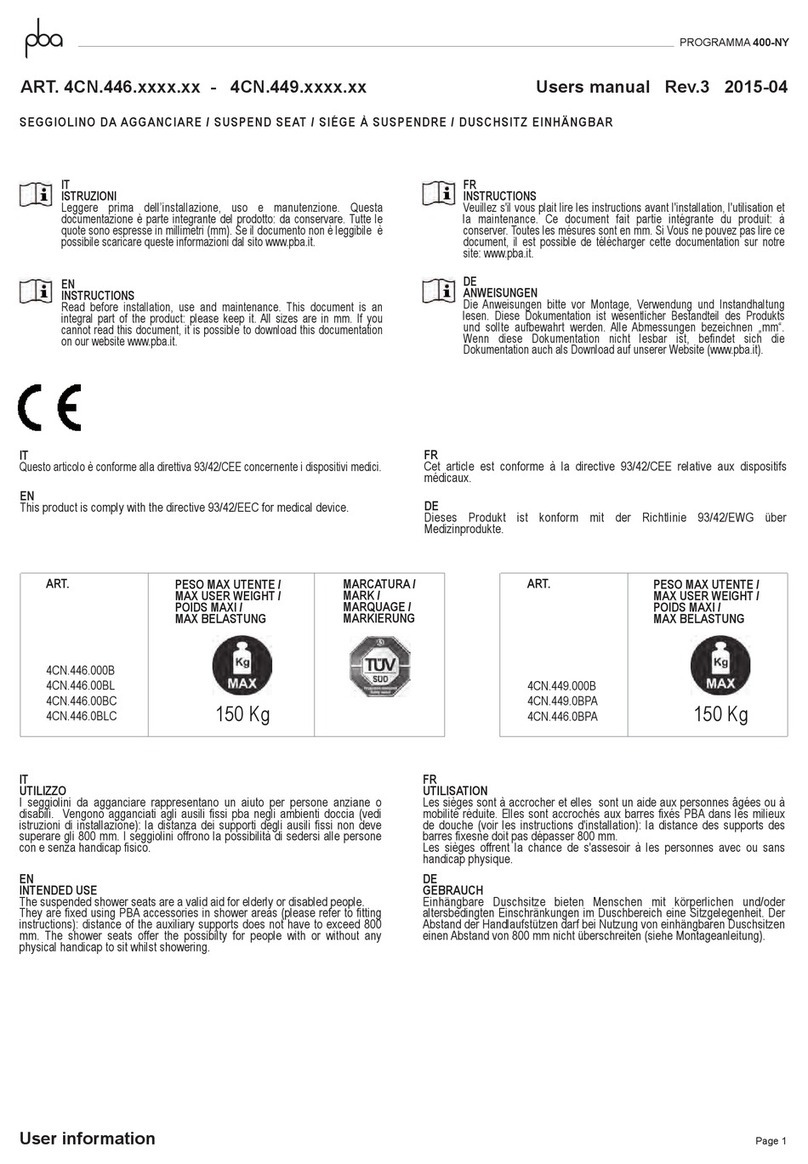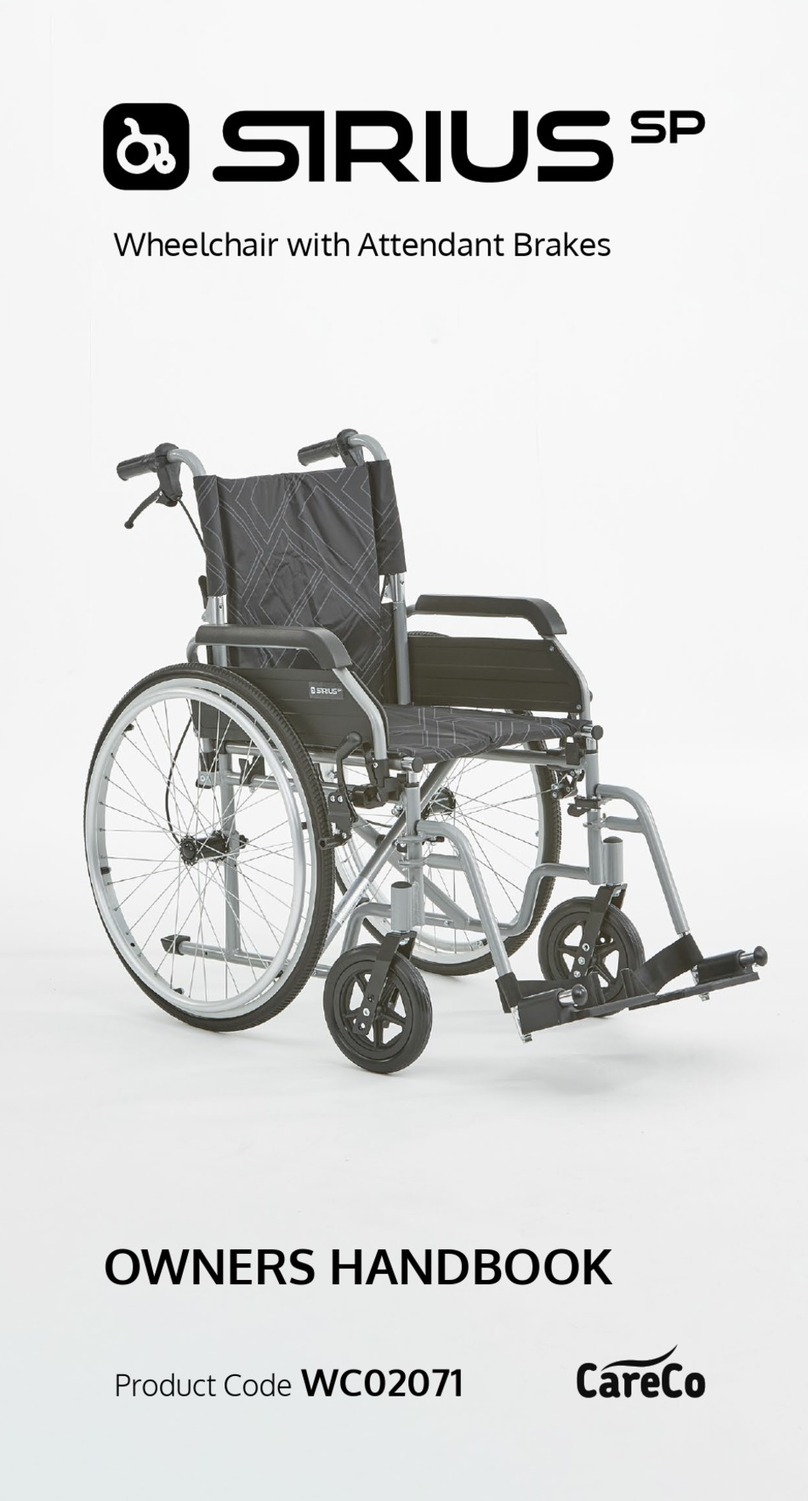TIGA Sub4 User manual

UserManual
Including:
TIGA Sub4
TIGA Junior
TIGA TX
EN
MANUAL WHEELCHAIR

Need replacementparts?
Takeadvantageofouronline pricingpolicyat; www.rgklife.com
UserManual
Issue No: 16 | 2016
2
We hope the product and service you have received has met your expectations. Please take time to read the instructions
contained within, to familiarise yourself with your new RGK chair and to ensure you get maximum performance and
longevity from it.
Russel Simms,
Commercial Director
Thankyou
forbuyingRGK…
WARNING:!
Do not operate this equipment without rst reading and understanding this manual.
If you are unable to understand the warnings and instructions, contact a healthcare
professional (doctor / therapist) before attempting to use this equipment - otherwise
injury or damage may result.
UserManual|Thankyou
As the manufacturer, RGK Wheelchairs
declares that the lightweight
wheelchairs conform to the 93/42/EEC
/ 2001/47/EEC guideline.
Please contact RGK or your local authorised RGK dealer if
you have any questions regarding the use, maintenance
or safety of your wheelchair.
RGK Wheelchairs, Units 8a/b/c , Ring Road, Zone 2 ,
Burntwood Business Park, Burntwood, Staordshire, WS7
3JQ, United Kingdom
info@rgklife.com

Need replacementparts?
Takeadvantageofouronline pricingpolicyat; www.rgklife.com
UserManual
Issue No: 16 | 2016
3
User Manual | Contents
Contents
4 Special Notes
4 Denitions of words used in this manual
4 Wheelchair Selection
5 Transportation
5 Safety Summary
5 Safety Summary
5 Environment
5 Finger Traps
6 Weight Training
6 Stability and Balance
7 General safety notes and driving restrictions
9 Lifetime
10 RGK TIGA Manual Propelled Wheelchair
10 Product Description
11 RGK TIGA Manual Propelled Wheelchair
12 Identication / Serial Number – Bespoke to you
13 Safety Handling of your Wheelchair
13 Tilting
14 Method 1
14 Method 2
15 Reaching, Leaning and Bending - Forward
15 Transferring to and from other seats
16 Transferring to and from other seats
17 Lengthening and shortening the wheelbase
17 Manoeuvring your RGK wheelchair
18 Safety Inspection Checklist
19 Troubleshooting Guide Mechanical
20 Maintenance
20 Suggested Maintenance Procedures
21 Procedure 1
21 Adjusting / replacing the back upholstery
22 Procedure 2
22 Seat Upholstery Replacement
23 Procedure 3
23 Removing rear wheels and attaching them to
and from your wheelchair.
24 Procedure 4
25 Procedure 5
25 Handrim replacement
25 Repairing / replacing rear wheel, tyre & tube
26 Procedure 6
26 Adjusting / replacing the camber bar
27 Procedure 7
27 Replacing Fork Assembly
27 Replacing Front Castor Wheels
28 Procedure 8
28 Wheel Locks - Adjustment / Replacement
29 Procedure 9
29 Adjusting / replacing the footrest
29 Angle adjusting the footrest platform
30 Procedure 10
30 Folding your backrest with cord support
31 Procedure 11
31 Height adjustable push handles
31 Flip-down push handles
31 Screw in Pushing Handles
32 Procedure 12
32 Adjusting the Anti-tipper
33 Procedure 13
33 Fixed Sideguards (All Materials)
33 Height Adjustable Armrest
Height Adjustment
34 Procedure 14
34 Location of the strapping
35 Technical Data
35 Recycling/Disposal
36 Warranty
36 GUARANTEE

Need replacementparts?
Takeadvantageofouronline pricingpolicyat; www.rgklife.com
UserManual
Issue No: 16 | 2016
4
Special Notes
The manual must be read thoroughly to avoid damage when handling and using your RGK Wheelchair.
User Manual | Special Notes
Denitions of words used in this manual
DANGER!
Advice to the user of a Potential Risk of serious injury or
death if the advice is not followed.
WARNING:
Advice to the user of a Potential Risk of
injury if the advice is not followed.
CAUTION:
Advice to user that Potential Damage to equipment may
occur if the advice is not followed.
NOTE:
General advice or best practice.
Wheelchair Selection
As a manufacturer of wheelchairs, RGK endeavours to
supply a wide variety of wheelchairs to meet many needs
of the end user. However, nal selection of the type of
wheelchair to be used by an individual rests solely with the
user and his/her health care professional capable of making
such a selection.
DO NOT use the footplate as a platform when getting in or
out of the wheelchair.
Always wear your seat restraint, if recommended.
The wheelchair shown and described in this user guide
may not correspond in every detail exactly to your own
model and accessories.
However, all instructions are completely relevant,
regardless of additions that you may have added at the
time of order
The expected life of your RGK wheelchair is 5 years of
normal use by a single user. The expected life of your
wheelchair is above all dependent on the user’s disability
and the maintenance of the wheelchair. Dierent users may
experience both a shorter and a longer service life for their
wheelchair than those stated above.
Please DO NOT use or t any third party components to
the wheelchair unless they are ocially approved by RGK
Wheelchairs Ltd.
NOTE:
The information contained in this document is subject to
change without notice.

Need replacementparts?
Takeadvantageofouronline pricingpolicyat; www.rgklife.com
UserManual
Issue No: 16 | 2016
5
Safety Summary
User Manual | Safety Summary
“Safety and Handling”of the wheelchair requires the close attention of the wheelchair user as well as the assistant.
This manual points out the most common procedures and techniques involved in the safe operation and maintenance of the
wheelchair. It is important to practice and master these safe techniques until you are comfortable in manoeuvring around the
frequently encountered architectural barriers.
Use this information only as a“basic” guide. The techniques that are discussed on the following pages have been used
successfully by many.
Individual wheelchair users often develop skills to deal with daily living activities that may dier from those described in his
manual.
RGK recognises and encourages each individual to try what works best for him/her in overcoming architectural obstacles that
they may encounter.
Techniques in this manual are a starting point for the new wheelchair user and assistant with “safety” as the most important
consideration for all.
Transportation
WARNING:
Wheelchair tie-down restraints and seat restraints.
• RGK recommends that wheelchair users not
be transported in vehicles of any kind while in
wheelchairs.
• It is RGK’s position that users of wheelchairs should
be transferred into appropriate seating in vehicles
for transportation and use be made of the restraints
made available by the auto industry.
• RGK cannot and does not recommend any
wheelchair transportation systems.
• As regards restraints-seat belts, it is the obligation
of the dealer, therapists and other health care
professionals to determine if a seating restraint
is required to ensure the safe operation of this
equipment by the user.
• Serious injury can occur in the event of a fall from a
wheelchair.
• DO NOT use the footplate as a platform when getting
in or out of the wheelchair.
Safety Summary
Never exceed the maximum user weight load, this
includes any additional items carried or attached on the
wheelchair. If you exceed the maximum load, this can lead
to permanent damage to your RGK wheelchair or you may
fall, tip over, lose control which may lead to serious injury to
either yourself or third parties.
Environment
WARNING:
Any products left in extreme hot or cold climates could
result in hot/cold surfaces which could result in personal
injury.
WARNING:
Do not expose the product or any of its accessories to any
form of excessive heat or naked ame.
Finger Traps
WARNING:
This product has moving parts and therefore could trap the
user’s ngers. Use extreme caution when moving.

Need replacementparts?
Takeadvantageofouronline pricingpolicyat; www.rgklife.com
UserManual
Issue No: 16 | 2016
6
User Manual | Safety Summary
Weight Training
RGK DOES NOT recommend the use of its wheelchairs as a
weight training apparatus. RGK products have NOT been
designed or tested as a seat for any kind of weight training.
If occupant uses said wheelchair as a weight training
apparatus, RGK shall NOT be liable for bodily injury and the
warranty will be voided immediately.
Stability and Balance
To assure stability and proper operation of your wheelchair,
you must at all times maintain proper balance. Your
wheelchair has been designed to remain upright and stable
during normal daily activities as long as you do not move
beyond the centre of gravity.
Virtually all activities which involve movement in the chair
have an eect on the centre of gravity.
Make sure the castors are pointing in the forward position
whenever you lean forward. This can be achieved by
advancing the chair and then reversing it in a straight line.
See Fig 1.
Fig 1
Castors pointing forward
Coping with the irritation of everyday obstacles can be
alleviated somewhat by learning how to manage your
wheelchair. Keep in mind your centre of gravity to maintain
stability and balance.
Safety Summary
WARNING:
The position of the footrest, camber tube, height, as well as
the tautness of the back upholstery are directly related to
the chairs stability. Any change to one or any combination
of the three may cause the chair to decrease in stability. Use
EXTREME caution when using a new seating position for
the rst time.

Need replacementparts?
Takeadvantageofouronline pricingpolicyat; www.rgklife.com
UserManual
Issue No: 16 | 2016
7
User Manual | Safety Summary
General safety notes and driving restrictions
The engineering and construction of this wheelchair has
been designed to provide maximum safety. International
safety standards currently in force have either been
fullled or exceeded in parts. Nevertheless, users may put
themselves at risk by improperly using their wheelchairs.
For your own safety, the following rules must be strictly
observed.
Unprofessional or erroneous changes or adjustments
increase the risk of accident. As a wheelchair user you are
also part of the daily trac on street and pavements, just
like anyone else. We would like to remind you that you are
therefore also subject to any and all trac laws.
Be careful during your rst ride in this wheelchair.
Get to know your wheelchair.
Before each use, the following should be checked:
• Quick-release axles on the rear wheels.
• Velcro on seats and backrests.
• Tyres, tyre pressure and wheel locks.
Before changing any of the adjustments of this wheelchair,
it is important to read the corresponding section of the
user´s manual.
It is possible that potholes or uneven ground could cause
this wheelchair to tip over, especially when riding uphill or
downhill. When riding over a step or up an incline frontally,
the body should be leaning forward.
DANGER!
NEVER exceed the maximum load of 125kg forTIGA/TX,
110kg forTIGA Sub4, 80kg forTIGA jnr. for driver plus
any items carried on the wheelchair. Please note the
weight information for lighter weight options, which
are quoted separately. If you exceed the maximum
load, this can lead to damage to the chair, or you may
fall or tip over, lose control and may lead to serious
injury of the user and other people.
Safety Summary
WARNING:
CHOKING HAZARD –This mobility aid uses small parts
which under certain circumstances may present a choking
hazard to young children.
• If and whenever possible, during a journey in a
specially fitted vehicle for disabled people, vehicle
occupants should use the seats in the vehicle and
the appropriate restraint system. This is the only way
to ensure that occupants will have the maximum
protection if there is an accident.
• To avoid falls and dangerous situations, you should first
practice using your new wheelchair on level ground
with good visibility.
• This wheelchair should be used exclusively to convey
one person at a time. Any other use does not comply
with the intended purpose.
• When getting on or off the wheelchair, do not use the
footboards. These should be flipped up beforehand
and swung to the outside as far as possible.
• Depending on the diameter and setting of the
castors, as well as the centre of gravity setting of the
wheelchair, the castors may begin to wobble at high
speeds. This can lead to the castors being blocked and
the wheelchair may tip over. Therefore, please make
sure that the castors are adjusted correctly (see the
Chapter “Castors”).
• In particular, do not travel on an incline without
brakes, travel at a reduced speed. This product
has been tested to a maximum speed of 10 kph. At
higher speeds, depending on the configuration and/or
physique/physical capabilities of the user, there may
be unexpected castor wobble. This can lead to injury of
the user.
• Riding sideways on to a slope or incline, increases the
possibility of the wheelchair tipping over sideways.
• Explore the effects of changing the centre of gravity
on the behaviour of the wheelchair, for example on
inclines, slopes, all gradients or when overcoming
obstacles. Do this with the secure aid of a helper.
• We recommend that novice users use anti-tip tubes.

Need replacementparts?
Takeadvantageofouronline pricingpolicyat; www.rgklife.com
UserManual
Issue No: 16 | 2016
8
User Manual | Safety Summary
• Anti-tip tubes should prevent the chair tipping over
backwards unintentionally. Under no circumstances
should they take the place of transit wheels, and be
used to transport a person in a wheelchair with the rear
wheels removed.
• With extreme settings (e.g. rear wheels in the most
forward position) and less than perfect posture, the
wheelchair may tip over even on a level surface.
• Lean your upper body further forward when going up
slopes and steps.
• Lean your upper body further back when going down
slopes and steps.
• Do not hang heavy items such as shopping bags or
backpacks, on the push handles, head rest or backrest
of the wheelchair.
• These can change the tipping point and there is a risk
of tipping backwards.
• When reaching for objects (which are in front of, to the
side or behind the wheelchair) make sure that you do
not lean too far out of the wheelchair, as if you change
the centre of gravity there is a risk of tipping or rolling
over.
• Only use your wheelchair properly. For example, avoid
travelling against an obstacle without braking (step,
kerb edge) or dropping down gaps.
• Only attempt stairs with the help of an attendant. There
is equipment available to help you, e.g. climbing ramps
or lifts, please use them. If there is no such equipment
available, then the wheelchair must be tipped and
pushed over the steps (2 helpers).
• In general, any anti-tip tubes fitted must be set
beforehand, so that they cannot touch the steps,
as otherwise this could lead to a serious tumble.
Afterwards the anti-tip tubes must be set back to their
correct position.
• Make sure that the attendant only holds the wheelchair
using securely mounted parts (e.g. not on the footrests
or the side guards).
• When using the lifting ramp make sure that the anti-tip
tubes fitted are positioned outside the danger area.
• Secure your wheelchair on uneven ground or when
transferring (e.g. into a car) by using the wheel locks.
Safety Summary
• For high amputees you must use anti-tip tubes.
• Before setting off, check that your tyre pressure is
correct. For rear wheels it should be at least 3.5 bar (
350 kPa). The max. pressure is indicated on the tyre.
• The knee-lever brakes will only work if there is
sufficient tyre pressure and if the correct setting has
been made (see the Chapter on “Wheel locks”).
• The wheel locks are not intended to brake your
wheelchair. They are only there to ensure that your
wheelchair does not begin rolling unintentionally. When
you stop on uneven ground, you should always use the
wheel locks to prevent such rolling. Always apply both
wheel locks; otherwise, your wheelchair could tip over.
• The wheel locks have not been designed to be used as
brakes for a moving wheelchair.
• Always make use of elevators and ramps. If these
are not available, you should request the help of an
attendant. They should only grip the wheelchair at
securely mounted parts. If anti-tip tubes are fitted these
must be folded away. A wheelchair should never be
lifted with an occupant; it should only be pushed.
• If the seat and back sling are damaged, you must
replace them immediately.
• Do not lift or carry the wheelchair by the back tubes or
the push handles.
• Do not fit any unauthorized electronic equipment,
powered or mechanically operated mobility drives,
hand-bike or any other device that changes the
intended use or the structure of the wheelchair.
• Any combination with other medical devices requires
the approval of Sunrise Medical.
• Be careful with fire, in particular with burning cigarettes.
Seat and back slings can be set alight.
• Always make sure that the quick-release axles on the
rear wheels are set properly and lock in. If the button
on the quick-release axle is not pressed in, the rear
wheel cannot be removed.
• In particular when using lightweight metal hand rims,
fingers will easily become hot when braking from a high
speed or on long inclines.

Need replacementparts?
Takeadvantageofouronline pricingpolicyat; www.rgklife.com
UserManual
Issue No: 16 | 2016
9
User Manual | Safety Summary
• If the wheelchair is subject to direct sunlight for a long
period of time, then parts of the wheelchair (e.g. frame,
leg rests, brakes and side guard) may become hot
(>41°C).
• To avoid hand injuries do not grab in between the
spokes or between the rear wheel and wheel lock
when driving the wheelchair.
• When using the chair outside, always wear leather
gloves which will increase your grip and protect the
fingers from dirt and overheating.
• Do not use the wheelchair on slopes > 10°.
• The Dynamic safe slope is dependant on the chair
configuration, the users abilities and the style of riding.
As the users abilities and style of riding cannot be
pre-determined then the max safe slope cannot be
determined. Therefore this must be determined by the
user with the assistance of an attendant to prevent
tipping. It is strongly recommended that inexperienced
users have Ant-tips fitted.
• Do not use your wheelchair on muddy or icy ground.
• Do not use your wheelchair where pedestrians are not
allowed.
• With all moving parts there is a natural risk of finger
traps. Please handle with care.
• The wheelchair should not be used in heavy rain,
snow, slippery, or unsound surfaces.
• Do not use the wheelchair in hazardous environments.
Lifetime
The expected lifetime of this product is 5 years.
Safety Summary
NOTE :
• The effect of the wheel locks as well as the
general driving characteristics are dependant
on tyre pressure. The wheelchair is significantly
lighter and easier to manoeuvre when the rear
wheels are pumped up correctly and both wheels
have the same pressure.
• Make sure that your tyres have sufficient tread!
• Please note that you are subject to any and all
traffic laws when driving in public traffic.
• When it is dark, please wear light clothing or
clothing with reflectors, so that you can be seen
more easily. Make sure that the reflectors on
the side and back of the wheelchair are clearly
visible. We would also recommend that you fit an
active light.
• Always be careful with your fingers when working
or adjusting the wheelchair!
• The products shown and described in this manual
may not be exactly the same in every detail as
your own model. However, all instructions are still
entirely relevant, irrespective of detail differences.
• The manufacturer reserves the right to alter
without notice any weights, measurements or
other technical data shown in this manual. All
figures, measurements and capacities shown
in this manual are approximate and do not
constitute specifications.
• Adjustments to your wheelchair, especially to
security-relevant components as for example
wheel-locks, anti-tip or backrest must be
performed by authorized dealers.
• When using add-on mobilty devices, such as
hand bikes, power add-ons etc, ensure that your
wheelchair is equipped with appropriate castor
forks intended for such use.

Need replacementparts?
Takeadvantageofouronline pricingpolicyat; www.rgklife.com
UserManual
Issue No: 16 | 2016
10
UserManual|ProductDescription
Product Description
The TIGA range, is a manually propelled wheelchair which is
suitable for a wide range of users whose mobility has been
reduced or removed by a disability or chronic illness. The
TIGA range is hand built from aerospace grade aluminium.
Two frame design options are available, either open frame
or a closed frame design, delivering a lightweight and
versatile wheelchair. The design incorporates an aluminium
frame, with either an integrated aluminium camber bar and
footrest suited to the more experienced users looking for
the lightest option, or can be prescribed with an adjustable
aluminium camber bar and adjustable height footrest,
scissor or push to lock brakes, adjustable tension seat sling,
backrest and calf strap all as standard, with further options
available.
The design accommodates a wide range of disabilities for
all ages of user up to a maximum user weight of 125kg for
TIGA/TX, 110kg for TIGA Sub4, 80kg for TIGA jnr.
Suitability is dependent upon the degree and nature of
disability and must be determined through a thorough
client risk assessment carried out by a qualied medical
professional or RGK personnel. This wheelchair is suitable
for a means of transfer from one location to another where
physical mobility is impaired or reduced and is not designed
for any other purpose.
Consideration must be given at point of prescription to
required usage with regard to the capabilities of the user
and the environment and terrain on which the product will
be used.
RGK TIGA Manual Propelled
Wheelchair
The TIGA range, manufactured by RGK Wheelchairs Ltd, is
CE marked as a Class 1 Medical Device and complies with
the Essential Requirements of the Medical Device Directive
93/42/EEC.
By denition all wheelchairs are marketed as a medical
device where a“medical device”* means an instrument,
apparatus, appliance, material or other article, whether
used alone or in combination, together with any software
necessary for its proper application, which-
(a) is intended by the manufacturer to be used for human beings
for the purpose of-
(i) diagnosis, prevention, monitoring, treatment or alleviation of
disease,
(ii) diagnosis, monitoring, treatment, alleviation of or
compensation for an injury or handicap,
(iii) investigation, replacement or modication of the anatomy or
of a physiological process, or
(iv) control of conception; and
(b) does not achieve its principal intended action in or on the
human body by pharmacological, immunological or metabolic
means, even if it is assisted in its function by such means.
* denition taken from the Medical Devices Directive 93/42/EEC

Need replacementparts?
Takeadvantageofouronline pricingpolicyat; www.rgklife.com
UserManual
Issue No: 16 | 2016
11
UserManual|ProductDescription
ABackrest
BBrakes
CRear Wheel
DFront Castor
EFront Castor Forks
FFootplate
GFootplate cover
HCamber Bar
IFrame
JUnder Seat Brace Bar
KCushion & Cover
LSideguard
RGK TIGA Manual Propelled
Wheelchair
F
or
ks
J
Under Seat Brace Bar
K
Cu
sh
io
n
&
Co
ve
r
L
Sideguar
d
A
DE
C
F
G
K
L
J
I
H
B

Need replacementparts?
Takeadvantageofouronline pricingpolicyat; www.rgklife.com
UserManual
Issue No: 16 | 2016
12
UserManual|Identification/Serial Number
Identication / Serial Number –
Bespoke to you
The serial number of your bespoke product is located on either the under seat
cross brace bar (J Product Description) or camber bar (H Product Description) or inside the backrest
upholstery (A).
Pleaseprovidethefollowinginformationwhenever youhavetoorderreplacement parts.
SerialNumber
Name
Dealer
TIGA Sub-4 TGA001 1/2013
00 44 (1)543 67 00 77
info@rgklife.com
MAXUSERWEIGHT125KG
RGKWheelchairsLtd
Unit8 b/cRing Rd,Zone 2
Burntwood Ind Est
Burntwood,Staffs
EnglandWS7 3JQ
AModel
BChair Serial Number
CMonth Manufactured
DYear Manufactured
EManufacturer Address
FManufacturer Contact Number
GManufacturer Email Address
HMaximum User Weight
RGK Chair Label Information
A
F G H
B C D E
EXAMPLE:

Need replacementparts?
Takeadvantageofouronline pricingpolicyat; www.rgklife.com
UserManual
Issue No: 16 | 2016
13
Safety Handling of your Wheelchair
Tilting
When tilting the wheelchair, an assistant should grasp the
back of the chair on a non-removable (non-detachable)
part. Inform the chair occupant before tilting the chair and
remind him/her to lean back.
Be sure the occupant’s feet and hands are clear of all wheels.
Apply a continuous motion until the balance point is
achieved.
At this point, the assistant will feel a dierence in the
weight distribution. Turn the chair in the desired direction
if necessary. Slowly lower the chair in one continuous
movement. See Fig 2.
DO NOT let the chair drop the last few inches
to the ground. This could result in injury to
the occupant.
Fig 2
CAUTION:
DO NOT tilt the chair without assistance. After mastering
the techniques of tilting the chair, use this procedure to
tackle kerbs, short stairs, etc.
User Manual | Handling of Wheelchairs
WARNING:
A note to wheelchair assistants
DO NOT attempt to lift the wheelchair by any removable
(detachable) parts.
Lifting by means of any removable (detachable) parts
of a wheelchair may result in injury to you the assistants
and damage your wheelchair.
NOTE: WHEELCHAIR ASSISTANTS
When assistance to the wheelchair user is required,
remember to use good body mechanics. Keep your
back straight and bend your knees whenever tilting the
wheelchair or traversing kerbs, or any other impediments

Need replacementparts?
Takeadvantageofouronline pricingpolicyat; www.rgklife.com
UserManual
Issue No: 16 | 2016
14
User Manual | Handling of Wheelchairs
Method 1
The assistant should tilt the chair until the front castors clear
the kerb. Roll the chair forward and lower the front castors to
the pavement. Push the chair forward until the rear wheels
roll up and over the kerb. See Fig 3 and Fig 4.
Fig 3
Fig 4
Method 2
The assistant should stand on the pavement and turn the chair
so that the rear wheels are against the kerb. The chair should
be tilted back to the balance point and, in one continuous
movement, the rear wheels should be pulled up and over the
kerb. See g 5.
Fig 5
DO NOT return the front castors to the ground until the chair
back has been pulled backward far enough to clear the edge
of the kerb. Unless the assistant has exceptional upper body
strength, it is recommended that two assistants be utilised
when choosing Method 2.
WARNING:
DO NOT attempt to lift a wheelchair by lifting on any
removable (detachable) parts. Lifting by means of any
removable (detachable) parts of a wheelchair may result in
injury to the user or damage to the wheelchair.
WARNING:
Extreme caution is advised when it is necessary to move
an occupied wheelchair up or down the stairs. RGK
recommends using two assistants and making thorough
preparations. Make sure to use ONLY secure, non-
detachable parts for hand-hold supports.

Need replacementparts?
Takeadvantageofouronline pricingpolicyat; www.rgklife.com
UserManual
Issue No: 16 | 2016
15
Reaching, Leaning and Bending - Forward
When reaching for any objects either in front, to the side or
behind your wheelchair make sure that you do not lean too
far out of your wheelchair, as this will change your centre of
gravity, and there is a risk of tipping or losing your balance.
The hanging of additional loads such as a laptop bag
or back pack on your backrest can aect the rearward
stability of your chair.This can cause your wheelchair to
lift at the front and the chair to tip backwards, potentially
causing injury or property damage.
WARNING
User Manual | Handling of Wheelchairs
DANGER!
DO NOT use an escalator to move a wheelchair between
oors as this could cause serious personal injury or
property damage.
Transferring to and from other seats
WARNING:
BEFORE attempting to transfer in or out of the wheelchair,
every precaution should be taken to reduce the gap
distance.Turn both castors toward the object you are
transferring onto. See Fig 6. Also be certain the wheel locks
are engaged to help prevent the wheels from moving.
Fig 6
CAUTION:!
When transferring, position yourself as far back as possible
in the seat. This will prevent damaged upholstery and the
possibility of the chair tipping forward.
WARNING:
Do not stand on footplate during transfer.

Need replacementparts?
Takeadvantageofouronline pricingpolicyat; www.rgklife.com
UserManual
Issue No: 16 | 2016
16
WARNING:
DO NOT attempt to reach objects if you have to move
forward in the seat or pick them up from the oor by
reaching down between your knees.
WARNING:
The position of the footrest, camber tube and rear seat
height, as well as the tautness of the back upholstery
are directly related to the chairs stability. Any change to
one or any combination of the four may cause the chair
to decrease in stability. Use EXTREME caution when
using a new seating position for the rst time.
Many activities require the wheelchair owner to reach, bend
and transfer in and out of the wheelchair. These movements
will cause a change to the normal balance, the centre of
gravity, and the weight distribution of the wheelchair.
To determine and establish your particular safety limits,
practice bending, reaching and transferring activities
in several combinations in the presence of a qualied
health professional BEFORE attempting active use of the
wheelchair.
Proper positioning is essential for your safety. When
reaching, leaning, bending or bending forward, it is
important to use the front castors as a tool to maintain
stability and balance. See Fig 7.
Fig 7
Castors pointing forward
User Manual | Handling of Wheelchairs
Transferring to and from other seats
WARNING:
RGK does NOT recommend that your wheelchair be
transported up or down stairways with you in it.
WARNING:
DO NOT attempt to lift the wheelchair by any
removable (detachable) parts. Lifting by means of any
removable (detachable) parts of a wheelchair may
result in injury to you the assistants and damage your
wheelchair.
NOTE:
Wheelchair Assistants
When assistance to the wheelchair user is required,
remember to use good body mechanics. Keep your
back straight and bend your knees whenever titling
the wheelchair or traversing kerbs, or any other
impediments.
NOTE:
This activity may be performed independently provided
you have adequate mobility and upper body strength.
Position the chair as close as possible along side the
seat to which you are transferring, with the front castors
pointing toward it, engage wheel locks. Shift body
weight into seat with transfer.
During independent transfer, little or no seat platform
will be beneath you. Use a transfer board if at all possible.

Need replacementparts?
Takeadvantageofouronline pricingpolicyat; www.rgklife.com
UserManual
Issue No: 16 | 2016
17
Lengthening and shortening the wheelbase
Lengthening the wheelbase will increase the stability and
maintain standard manoeuvrability of the chair.
Shortening the wheelbase will increase the manoeuvrability
and distribute additional weight onto the rear wheels.
To lengthen the wheelbase move Camber Bar toward the
rear of the frame. See Fig 8.
To shorten the Wheelbase move the Camber Bar toward the
front of the frame. See Fig 8.
A = Rearward / Lengthen B = Forward / Shorten
Fig 10
A B
Fig 8
Manoeuvring your RGK wheelchair
WARNING:
BEFORE attempting to manoeuvre your new wheelchair it
is important to practice and master these techniques until
you are comfortable and competent.
WARNING:
During operation, handrims can get hot when being used
to slow down. Extra caution is to be used when going
downhill.
WARNING:
Manoeuvring across a slope may aect the stability of the
wheelchair. Use extreme caution on slopes.
User Manual | Handling of Wheelchairs
WARNING:
Any change in axle position can aect your centre of gravity and stability.
Remember to lean your upper body further forward when
going up slopes and steps. See Fig 9.
Fig 11Fig 9
Remember to lean your upper body further back when
going down slopes and steps. See Fig 10.
Fig 12Fig 10
Never try to climb or descend a slope diagonally.
See gure 11.
Fig. 11

Need replacementparts?
Takeadvantageofouronline pricingpolicyat; www.rgklife.com
UserManual
Issue No: 16 | 2016
18
Safety Inspection Checklist
Item
Initially
Inspect /
Adjust
Weekly
Inspect /
Adjust
Monthly
Inspect /
Adjust
Yearly
General
•Wheelchair rolls straight (no excessive drag or pull to one side).
•Frame - Inspect frame for cracks and damage
•Fasteners - Inspect all fasteners are secured
Wheel Locks
•Do not interfere with tyres when rolling
•Pivot points free of wear and looseness
•Wheel locks easy to engage
Seat and Back Upholstery
•Inspect for rips or sagging.
•Inspect fastening aps to ensure they securely latch
Rear Wheels
•Adjustable Axle Position Camber Bar is securely tightened.
•Quick/Quad release axles lock properly
•No excessive side movement or binding when lifted and spun.
Handrims
•Inspect for signs of rough edges or peeling.
Spokes
•Inspect for bent or broken spokes.
•All spokes uniformly tight.
Front Castor
•Inspect wheel/fork assembly for proper tension by spinning castor;
caster should come to gradual stop.
•Loosen / tighten locknut if wheel wobbles noticeably or binds to a stop.
•Wheel bearings are clean and free of moisture.
CAUTION: As with any vehicle, the wheels and tyres should be checked
periodically for cracks and wear, and should be replaced when necessary.
Tyres
•Inspect for at spots and wear
•If pneumatic tyres check for proper ination.
CAUTION: As with any vehicle, the wheels and tyres should be checked
periodically for cracks and wear, and should be replaced when necessary.
Cleaning
User Manual | Safety Inspection Checklist
NOTE:
Regular cleaning will reveal loose or worn parts and enhance the smooth operation or your wheelchair. To operate properly
and safely, your wheelchair must be cared for just like any other vehicle.
Routine maintenance will extend the life and eciency of your wheelchair. Initial adjustments should be made to suit your
personal body structure and preference. Thereafter follow these maintenance procedures.

Need replacementparts?
Takeadvantageofouronline pricingpolicyat; www.rgklife.com
UserManual
Issue No: 16 | 2016
19
User Manual | Troubleshooting Guide Mechanical
Troubleshooting Guide Mechanical
Chair veers right
Chair veers left
Sluggish turn or
performance
Castor utters
Squeaks
and rattles
Loose-ness
in chair
Solutions
Check tyres for correct and equal pressure
Check for loose castor stem nuts
Check all xtures are secure and tight.
Check spokes and nipples for tension
Check that both castors contact the ground at the same time
WARNING:
After making adjustments, always make sure that parts are properly tightened BEFORE using the wheelchair.
DO NOT over-tighten hardware attaching to the frame.This could cause damage to the frame tubing.

Need replacementparts?
Takeadvantageofouronline pricingpolicyat; www.rgklife.com
UserManual
Issue No: 16 | 2016
20
Suggested Maintenance Procedures
1. Before using your RGK Wheelchair, make sure all nuts
and bolts are tight. Check all parts for damage or wear
and replace. Check all parts for proper adjustment.
Adjustments should always be carried out by an
authorised RGK dealer.
2. Keep quick / quad-release axles free of dirt to ensure
positive locking and proper operation. Refer to adjusting
the quick-release axle or adjusting the quad-release axle
in Procedure 3 of this manual.
3. Clean and polish Quick-Release Axles once a month – DO
NOT OIL.
4. Recommended tyre pressure is listed on the side wall of the
tyre.
5. The wheels and tyres should be checked periodically for
cracks and wear, and should be replaced when necessary
at your authorised dealer.
6. Regularly check for loose spokes in the rear wheels. If loose,
have them adjusted at your authorised dealer.
WARNING:
Do not use the wheelchair unless it has the proper tyre
pressure (P.S.I). DO NOT over inate the tyres. Failure to
follow these suggestions may cause the tyre to explode
and cause bodily harm.
7. Periodically check handrims to ensure they are secured
to the rear wheels. Refer to handrim replacement in
procedure 5 of this manual.
8. Periodically adjust wheel locks in correlation to tyre
wear. Refer to adjusting wheel locks in procedure 8 of
this manual.
9. Periodically check castor wheel bearings to make sure
they are clean and free from moisture. Refer to replacing
your front castor wheels in procedure 7 of this manual.
10. Check upholstery for sagging, rips or tears. Adjust or
replace as necessary
User Manual | Troubleshooting Guide Mechanical
Maintenance
11. The seat upholstery is secured by means of Velcro straps
around the frame. The upholstery can easily be removed
from the frame by loosening the straps under the seat.
Refer to placing your seat upholstery see procedure 2 of this
manual.
12. The backrest upholstery is removed by loosening the cover,
detaching the centre pad and wings, Refer to adjusting /
replacing your upholstery see procedure 1.
13. Wipe down the seat and backrest upholstery with a clean
damp cloth. It is important to keep the wheelchair clean,
both for your own comfort and longevity of the chair. Clean
the frame with a non-abrasive cleaning agent.
NOTE:
It is recommended to clean and disinfect the frame and
upholstery frequently.
Store wheelchair in a cool, dry place out of direct sunlight and
in original packaging.
WARNING:
Do not reuse single use fasteners. Contact your authorised
dealer for more information.
WARNING:
Exclusively use genuine RGK spare parts. Never use third-
party parts that are not approved by RGK.
This manual suits for next models
2
Table of contents
Popular Wheelchair manuals by other brands

Alu Rehab
Alu Rehab NETTI S user manual

Ortopedia
Ortopedia ALLROUND 970 operating manual
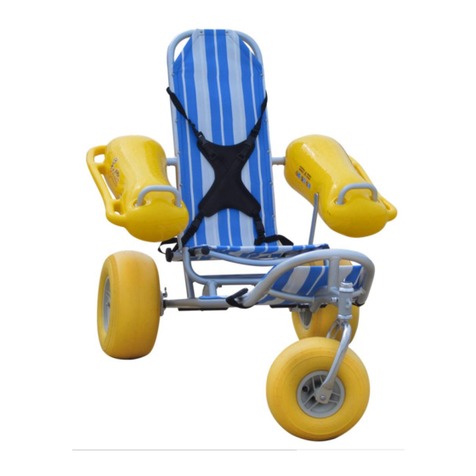
AccessRec
AccessRec WaterWheels Instruction, Maintenance and Safety Manual
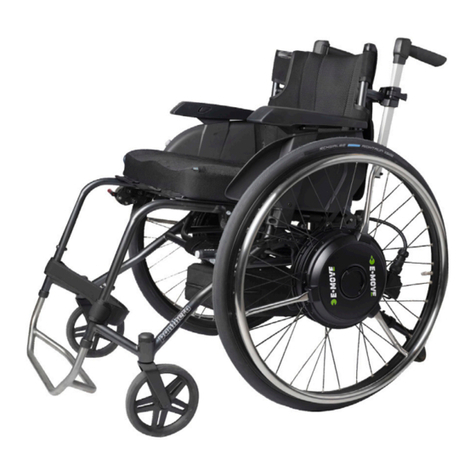
decon
decon E-Move MEM20 user manual

Drive DeVilbiss Healthcare
Drive DeVilbiss Healthcare Silver Sport Wheelchair Instructions for use

DELTA-SPORT
DELTA-SPORT 315318 Instructions for use


